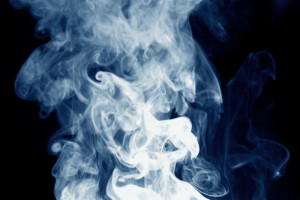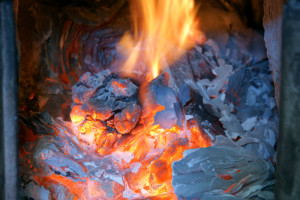by Billy Sweet | Mar 26, 2016 | Seasoned Firewood, wood burning
Where There’s Smoke, There’s Fire
Yes, smoke generally means a fire exists. However, in your fireplace or furnace, smoke usually indicates a less-than-efficient fire. If your fireplace is smoky, you most likely have a problem with your fuel, or with your venting system.

Proper Fuel
It is very important to choose properly seasoned wood to burn in your fireplace or furnace. If your wood is green or wet it will burn slower, less hot, and maybe incompletely. When green or wet wood is burned it often doesn’t burn hot enough to push the smoke up the chimney, causing the smoke to stall, and fall back down.
Improper Use or Maintenance
If your fireplace is releasing excess smoke into your home, you should first check the damper. The damper should be open in order to allow the smoke to rise up the chimney. If the damper lever is opened, the opening may be blocked by soot buildup or debris. Like the damper, if the chimney isn’t routinely cleaned, layers of soot can prevent the smoke from rising up the chimney and out of the home. You can schedule your routine chimney sweeping to have your chimney flue and damper cleaned thoroughly.
Venting Problem
In order for gas to leave the home through the chimney, it has to pull from inside the home. When air is removed from the home it must be replaced. Modern homes are built tight, so air isn’t pulled from outside as the gases attempt to rise up the chimney. Even adding insulation or replacing windows in the home can create a smoke problem for this reason. An easy way to fix this problem is to open a window in another part of the home.
Also, it’s important to note that other home appliances can compete with the ventilation of the chimney. Even something as simple and harmless as a ceiling fan can compete with your chimney. Also, a leaky chimney can disrupt the draft of your fireplace.
Regardless of the cause, no home or business owner wants to deal with a smoke problem in the fireplace or furnace. Not only is it unpleasant, but it can cause respiratory issues if not corrected, and can also be a fire hazard. If the heated gases aren’t moving up the chimney, they can stall in the chimney flue and cause a flue fire. Because your chimney system is important, and the safety of your family and property are our top priority at Billy Sweet Chimney Sweep, we recommend calling a professional if a smoking fireplace persists. Schedule your appointment today.
For more information about why your chimney isn’t working, check out the Chimney Safety Institute of America (CSIA) and “100 Reasons Your Fireplace Doesn’t Work”.
by Billy Sweet | Feb 25, 2016 | Fire Safety, wood burning, Wood Stove
Hazardous Waste
Depending on your appliance you may have an ash box beneath your fire box. Some of these actually pull out, allowing you to easily dump it. Others have a door beneath the firebox for ash removal, and some furnaces keep the ash in the firebox itself. No matter the type of appliance you use, however, the ash can build up quickly and become a hazard.
Ashes can be dangerous because even when they look cold, and seem cold, they can actually be very hot. These ashes, when allowed to fill the firebox, can fall out onto carpet, or nearby combustibles in your home and catch fire. They can also be dangerous if handled incorrectly.
Recommended Tools
Ash Bucket
You can pick up an ash bucket at a local hardware store or get a recommendations from one of our Billy Sweet Chimney Sweeps.
Ash Shovel
Many fireplace tool sets will come with a shovel, a broom, and a poker. You may find that you need a longer shovel to keep your hands or face away from the fire or hot coals.
Gloves
Though not required, you may find that gloves add extra protection to your skin while removing hot coals and ashes.

When to Remove Ashes
Although it seems a good idea to remove ashes often, some even removing them daily, it isn’t recommended. Chimney Safety Institute of America (CSIA) recommends leaving at least an inch of ash in the fire box at all times. This ash insulates the coals to keep them hot longer, while also keeping the bottom of the firebox cool, protecting your furnace and your flooring from excess heat.
However, it is a good idea to remove ashes when they begin to cover the coals following a regular burn cycle.
Removing the Ash
When you’re ready to remove the ash you should have the ash bucket on hand. Shovel the ashes into the bucket, taking care to not stir the ash more than needed. Shovel the ashes from the back of the firebox where there may be buildup, and remove it from the front where it may cover a vent. Once you have shoveled all you want into the bucket, set it aside to cool. It can cool outside or inside, but should be kept away from combustibles.
Disposing of Ash
In some areas and cities you may be able to bag cooled ashes, and simply place them with your regular trash pick-up. If this isn’t a possibility for you, you may want to utilize those ashes in creative ways. Some ways people use ashes include:
- In the garden. You can mix ashes with soil to change the acidity or sprinkle ashes directly onto plants to repel bugs.
- In the kitchen. You can mix ashes with water to shine silver, and clean glass and stainless steel. Save on oven cleaner by keeping this mixture on hand.
- On the driveway. Spread ash onto the driveway, porch, or sidewalk to add traction and to melt ice during winter weather.
- On your pet. To neutralize odors on household pets, rub a small amount of ash into the fur. You can also use ashes beneath cat litter to neutralize odors in the litter box.
However you use your ashes, it’s important to take safety precautions to prevent fire, burns, and injury.
by Billy Sweet | Aug 10, 2014 | environment, firewood, wood burning, wood burning fireplace, wood storage, Wood Stove
Wood-burning fireplaces serve several functions in the home – from practical to aesthetic. Sometimes the fireplace is used to heat the home, while in other cases it acts as a beautiful, focal point on special occasions. Either way, owners of wood-burning fireplaces generally love everything their fireplaces have to offer. Aside from the regular chimney maintenance, most home owners don’t put much extra thought into the specifics of their fireplace, including purchasing the wood for fuel. The goal is usually to find the cheapest wood that burns the longest, but more care should go into choosing the right firewood – especially where it comes from.

Always investigate the source of your firewood before you purchase to ensure it has come from a local source. The Don’t Move Firewood campaign says “local” means within a county or two of where you plan to transport, store and burn the firewood. If the firewood came from any further than a few counties away, find a more local source. At the same time, if you plan to travel more than a few counties away with your firewood, choose to purchase wood more local to your destination instead. Importing wood from a different area can have devastating environmental effects.
Firewood is a good representation of the ecosystem that it originated from. It often contains native species, such as insects, fungi and bacteria. Sometimes these species can be seen on the firewood, but more often than not, they’re invisible to the human eye. For the trees and other plant life in the ecosystem the firewood came from, these organisms generally do not cause serious ill effects. For thousands and even millions of years, the trees, insects, fungi and bacteria have lived and evolved together and have achieved a natural balance. By moving firewood out of its original area though, you introduce these organisms to an ecosystem unaccustomed to them, which can have serious consequences.
An insect, fungus or bacteria introduced to an environment it has never inhabited before is called a nonnative or invasive species. These organisms have no natural enemies in the new system, and before the environment has an opportunity to adjust to the invasion, the intruding species has had the opportunity to grow rapidly and further infiltrate the area.
One consequence of this fast overpopulation is that similar, native species are outcompeted by the invasive species for shared resources, resulting in a decrease in the native species’ population. Another consequence is the introduction of disease. For example, the Emerald Ash Borer – a beetle originally from Asia – was found in Michigan in 2002 after it was accidentally introduced there. The beetles do little damage to the Ash trees they inhabit, but the larvae inside the trees disrupt the tree’s ability to transport water and nutrients. Now, nearly every state in the eastern half of the United States has been affected and tens of millions of Ash trees have died. These beetles would not have traveled far on their own, but with the movement of firewood, logs and nursery trees, the damage has devastated the Ash tree population.
Countless other examples of this have occurred throughout the country and continue to occur as long as people refuse to keep firewood local. Trees and plant life are vital to the health of the environment for generations to come, so do your part to maintain the ecosystems around you by purchasing and burning firewood locally.



